Episodes
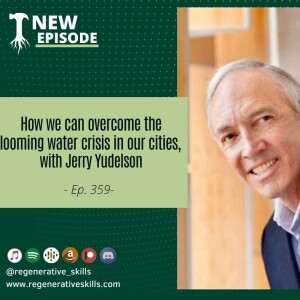
Friday Oct 11, 2024
Friday Oct 11, 2024
In this series on water, the one area that I've left out so far is the urban landscape. In this week’s episode I got to chat with Jerry Yudelson, the author of 13 full-length professional and trade books on green buildings, integrated design, green homes, water conservation, building performance and sustainable development. Dubbed ‘The Godfather of Green’ by Wired Magazine, Jerry’s passion for optimizing the built environment is reflected by his many years of professional experience in the green building and certification fields, serving as an elected LEED Fellow and as president of the Green Building Initiative. He also served on the national board of the USGBC and chaired the Steering Committee for the largest green building show, Greenbuild, from 2004 through 2009.
Despite being best known for ecological building design and policy, in this interview we’re going to focus on his book Dry Run, which unpacks some of the best ways to manage scarce water resources and handle upcoming urban water crises. The book explains the most pressing water issues that urban zones face, and examines the vital linkages between water, energy use, urban development and climate change. Dry Run also demonstrates best practices for achieving “net zero” water use in the built environment through, water conservation strategies for buildings, factories, cities and homes, rainwater harvesting, greywater reuse and water reclamation systems, water efficiency retrofits, onsite sewage treatment, and new water reuse and supply technologies.
In this interview we specifically address the urgent changes that cities need to make to ensure longer term water security. Jerry explains his classifications of the colors of water that help to categorize the different sources and uses for water in cities that require different management systems, and gives a few case studies of municipalities that have started to make improvements in their aquatic infrastructure.
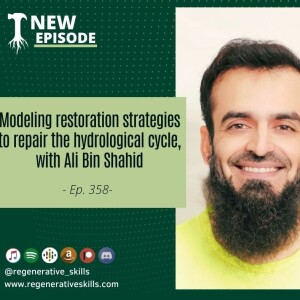
Friday Oct 04, 2024
Friday Oct 04, 2024
As the importance of the water cycle to global climate regulation has gained attention in the last few years, I’ve also seen an emergence of voices working to explain the science and the details of the intricate workings and contributors to the nuance of water cycles. One of my favorites and one I’ve come to count on to consistently expand my understanding about working with water is that of Ali Bin Shahid, an engineer turned permaculturalist based in Islamabad Pakistan working to capture the rhythms of nature through quantification.
In his substack blog, R3genesis, he writes about topics such as Enhancing bioprecipitation through afforestation, mapping a rain plan for the Valencia region of Spain, how beetles drive ecosystem dynamics, and so much more. His ability to make important connections between small actors in the environment with macro processes in our ecosystem and the ways in which this knowledge can be put to use in our lives. In this conversation Ali and I explore his journey and passion around ecosystem restoration, how his background in engineering is opening new possibilities by modeling landscape hydrology, new technologies that can be used to bridge scientific disciplines for new discoveries, and how these models can inform a new generation of water and climate wise policy and incentive mechanisms.
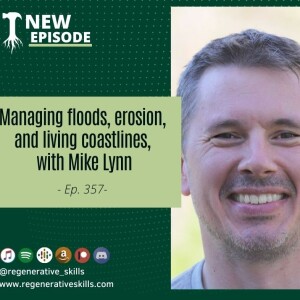
Friday Sep 27, 2024
Friday Sep 27, 2024
So much of the conversation around water revolves around its scarcity. Today we’ll get a chance to explore how to manage water regeneratively when the challenge is having too much. As arid zones become drier, the opposite is proving true for humid zones. The North American eastern seaboard is looking like an emblematic case of this. As storms become stronger and charged with massive evaporation from warmer temperatures and a warmer ocean, flooding erosion and saturation are becoming bigger issues. Coastlines as well are struggling with these issues as well as the degradation of their delicate vegetation, and poorly applied gray infrastructure. To get a better understanding of these ecological challenges, I reached out to a good friend Mike Lynn.Michael Lynn is an ecological designer with United Designers International and owner of Eastern Ecosystems. He has worked on numerous projects around the world including large-scale watershed restoration, agricultural and agroforestry production systems, and ecological restoration. Around the Chesapeake Bay in the US, he works with storm water management, ecological restoration, and living shorelines projects. With a passion for education, Mike provides training for a wide array of audiences.
Mike has worked in ecological design for more than a decade, starting out with small scale homestead and farm designs to large scale landscape design, watershed management, and ecosystem restoration. Having had a career in public safety, He’s seen first hand the devastating effects of climatic disasters and I recognize that nature based solutions are the way forward.
In this episode we’ll not only explore Mike’s fascinating background and path to ecological design, we’ll take the time to focus on the evolving challenges of water management when safe drainage and removal of excess water is the objective over retention and capture.

Friday Sep 20, 2024
Friday Sep 20, 2024
In this session I hosted a discussion on the importance of restoring proper hydrological function in a landscape and the steps to achieving it with my friends and colleagues at Climate Farmers, a non-profit organisation working to advance regenerative agriculture in Europe.
In this panel I got to speak with three of the most experienced and influential educators working on this from a farming perspective. Since landscape hydrology and its proper function is often overlooked in its importance in regulating global temperature, I wanted to focus on this specifically. I was lucky enough to bring together three of the experts that have most guided my learning in this field, Zach Weiss, Nicole Masters, and Mark Shepard.Don’t forget that if you want to see the video of the full event, you can check it out on the Climate Farmer’s Youtube channel through the link in the show notes for this episode.
Zach Weiss is the protégé of revolutionary Austrian farmer Sepp Holzer, Zach is the first person to earn Holzer Practitioner certification directly from Sepp. Zach went on to create Elemental Ecosystems to provide an action-oriented process to improve clients’ relationship with their landscape. Elemental Ecosystems is an ecological development, contracting, and consulting firm specializing in watershed restoration and ecosystem regeneration. The firm’s work includes Aquaculture, Agroforestry, Water Retention Landscapes, Terrace Systems, Spring Development, Natural Building, and more.
Mark Shepard is the CEO of Forest Agriculture Enterprises LLC, founder of Restoration Agriculture Development LLC and award-winning author of the books, Restoration Agriculture and Water for Any Farm. He is most widely known as the founder of New Forest Farm, the 106-acre perennial agricultural savanna considered by many to be one of the most ambitious sustainable agriculture projects in the United States.
Nicole Masters is is an independent agroecologist, systems thinker, storyteller, educator and author of the book “For the Love of Soil.” With over 20 years of practical and theoretical experience in regenerative agriculture, she is also recognised as a knowledgeable and dynamic speaker on the topic of soil health. Her team of soil coaches at Integrity Soils work alongside producers in the U.S., Canada and across Australasia supporting producers and organisations who cover over 24 million acres, to take their landscapes to the next level in nutrient density, profitability and environmental outcomes.
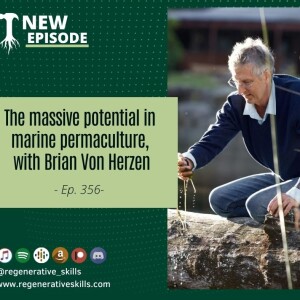
Friday Sep 13, 2024
Friday Sep 13, 2024
Continuing today with this ongoing series on waterway regeneration and a deep dive into marine ecosystems, I had the pleasure of speaking with Brian Von Herzen.
Brian is an ocean scientist, engineer and entrepreneur, though much of his career has been in Silicon Valley where he developed innovative technical solutions for companies like Pixar, Dolby and Microsoft. Brian is also the founder and Executive Director of the non-profit The Climate Foundation, an institute working to regenerate life in the world’s oceans and reverse global warming within our lifetimes.
Through Brian’s work with the Climate Foundation, he’s been promoting the concept of marine permaculture through ocean seaweed and kelp farming in a way that could potentially revitalize areas of degraded coastline as well as spark a whole new economy around marine ecosystem stewardship.
In this interview, Brian starts by explaining just how immense and important the kelp forests of the world are by describing the impact that they’ve had on the ecology of the west coast of the United States. I think it’s so important to regain reference to what our healthy and intact biosphere used to be, because all of us alive today have almost no reference to what our natural world even looked like before humans started to alter and degrade it so severely.
Brian also breaks down what it could mean for the economy and health of the west if these underwater forests could be regenerated and cared for.
We also explore some of the challenges in getting sea farming and ocean permaculture projects started and especially funded, since the initial costs are often much higher than land based initiatives.
We cover a lot of ground in this talk and even touch on topics like how marine farming fits into a regenerative economy and what those of you listening can do to support and even start your own marine permaculture projects, so be sure to stick around for some great action steps by the end.
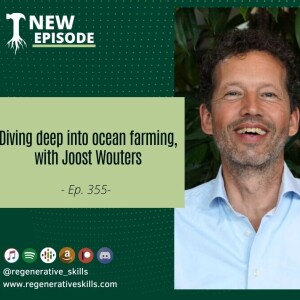
Friday Sep 06, 2024
Friday Sep 06, 2024
Today I want to continue with a deeper dive into the topic of water, literally, by going to the furthest point downstream, where terrestrial water enters the ocean.
Marine ecosystems are much less understood by the general public for a variety of reasons, but our actions on land have a direct effect on the health of our oceans too. Luckily there are incredible teams of people looking to address these issues with promising new solutions and over the next couple of episodes I’ll be highlighting a few of them.
To get things started I spoke to Joost Wouters, an entrepreneur, speaker, author and the ‘Sea’EO of the Seaweed Company. I got to know Joost first as a co-instructor with me on the Ecosystem restoration design course through Gaia Education. I was fascinated with his presentation and the compelling data on the potential regenerative effects that seaweed and kelp can have in bringing back the health of coastal areas. In his role with the Seaweed Company, he and his team aim to implement CO2-reducing seaweed-based business models at large scale.
It turns out that seaweed is the fastest growing biomass in the world. Seaweed farming itself, if done responsibly, has the power to address many of the ecological challenges we face today, without the use of land, fertilizer, or freshwater. It reduces ocean acidification, promotes marine biodiversity, and even absorbs vast quantities of CO2 from the atmosphere.
Seaweed can also create highly valuable end products. It is a nutritious food source for both people and animals and can be used as an environmentally friendly alternative to petroleum-based fertilisers and plastics. At the moment it’s a unique untapped resource, and the goal of the Seaweed Company is to unlock the potential of this wondrous resource to benefit both people and the planet.
In this episode Joost starts by explaining some of the urgent issues facing marine environments and how seaweed farming can help to address them. We go over the advantages that growing seaweed has over terrestrial agriculture, the high value products that can be made from different types of seaweed, the many pilot projects around the world that his company has helped to start and much more.
Towards the end we also examine the roadblocks that are holding this solution back from being more widely adopted and how those of you listening can learn more and get involved.
I’ve personally been learning a lot about marine ecosystems through these interviews and truly hope that a greater awareness will begin to be built around just how essential the health of our oceans is to the health of all life, even to ecosystems that are far inland and away from any saltwater. I’m really excited for this and the next few episodes for this reason.
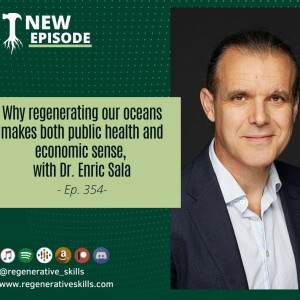
Friday Aug 30, 2024
Friday Aug 30, 2024
While the climate change narrative has mostly focused on the concentration of CO2 and other greenhouse gasses in the atmosphere since the industrial revolution, we’ve ignored the essential role that the water cycle plays in regulating global temperatures. In this series I’ll be speaking to an incredible list of scientists, farmers, and restorationists who are dedicated to reviving the precious waterways of the world. From the urban environment to the deep seas, our actions will determine whether or not we preserve our aquatic resources and all the life that depends on them for future generations.
In this first episode I got to speak with Enric Sala, a renowned ecologist making a clear case for why protecting nature is our best health insurance, and why it makes economic sense. Enric is the director of National Geographic’s Pristine Seas project (which has succeeded in protecting more than 5 million sq km of ocean and created 22 marine reserves). Dr. Sala has received the Young Global Leader Award by the World Economic Forum, a Research Award from the Spanish Geographical Society, the Lowell Thomas Award from the Explorers Club, and a Hero Award from the Environmental Media Association. In his new book “The Nature of Nature: Why We Need the Wild,” he tells the story of his scientific awakening and his transition from academia to activism. More importantly, he shows the economic wisdom of making room for nature, even as the population becomes more urbanized, and how saving nature can save us all, by reversing conditions that led to the coronavirus pandemic and preventing other global catastrophes.
In this interview we begin by unpacking the changes that have occurred in our oceans in the last few decades and how this is affecting people all over the world, even if you don’t live anywhere near the sea.
Enric also offers a lot of hope that our oceans can recover if we act swiftly and give them the space and protection to regenerate.
I learned a lot from this talk and as I begin to learn more about how marine health is closely linked to terrestrial health, I would encourage those of you listening to examine how your own habits and lifestyle choices are connected to ocean health in ways that can be hard to see.
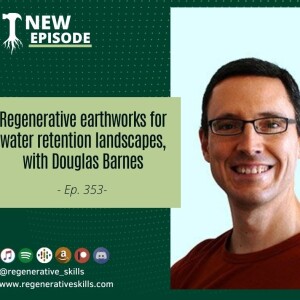
Friday Aug 23, 2024
Friday Aug 23, 2024
My guest today is here to demystify one of the aspects of permaculture design that I hear the most questions about, but also one of the issues that I see folks most entrenched in their viewpoints about. I’m talking about earthworks; one of the first aspects that people implement and the most permanent change made in a landscape. Today I’ve got Douglas Barnes, author of “permaculture earthworks” and owner director of EcoEdge Design Ltd. to answer our questions and take the guess work out of the subject of terrain changes.
In this interview Douglas talks about the best way to map out contours on the land, some of the most effective ways to harvest rainwater on a site, how to link up various earthwork and containment systems to make them work in tandem, and most importantly, he talks in detail about many of the safety concerns that many people have no idea about when it comes to installing swales and dams.
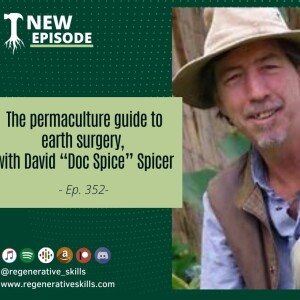
Friday Aug 16, 2024
Friday Aug 16, 2024
I spoke with David Spicer, affectionately known as Doc Spice, an accomplished permaculture designer who has specialized in earthworks installation. Having taught and worked on various projects extensively within Australia and internationally, in places such as Morocco, Jordan, Palestine and New Caledonia, Doc has worked in a broad array of different soil types, topographies and climatic zones.
He’s also a valued member of the Permaculture Sustainable Consulting team headed up by Geoff Lawton and is registered Teacher #5 with the Permaculture Research Institute of Australia.
Doc is a master of practical and logical mainframe permaculture design and he’s pioneered the design of water harvesting and storage earthworks which frames all regenerative farming.In this episode we talk about why it’s so important to invest early on in a project to get your earthworks right because of what it can mean for the health of your land. Doc also shares some insights on his personal design process and what he looks for in a landscape to give him clues as to the most effective interventions on the form of the land. We also cover some of the risks of improperly installed features, the need to draw from as many sources of knowledge as possible and he also gives some valuable advice for people who are new to earthworks on how to get started.
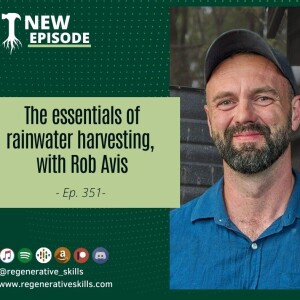
Thursday Aug 08, 2024
Thursday Aug 08, 2024
In keeping with the theme of water regeneration this month I spoke to Rob Avis, the co-author along with Michelle Avis of their book in the New Society Essentials series called Rain Water Harvesting.
Rob and Michelle founded Verge Permaculture, an award-winning design, consulting and education company in Calgary, Alberta after years of international training in renewable energy and regenerative design. Since its founding, Verge has helped more than 1000 students and clients to design and create integrated systems for shelter, energy, water, waste, and food, all while supporting their local economy and regenerating the land. Through their design and consulting they create havens that produce their own energy and food, harvest water, cycle nutrients, and restore the surrounding ecosystems, enabling property owners to thrive no matter what. With such a broad range of knowledge, experience, and expertise, we focused mainly on rain water harvesting techniques and systems in this episode as an entry into the larger concept of watershed regeneration and revival.
In this session Rob explains some of the key components of rain water harvesting systems and the ways that you can treat and filter the water for various uses. We talk at length about why expensive filters and disinfectants are often unnecessary, even for most potable water uses, and the different ways you can keep your stored rainwater clean. Rob also speaks about how rainwater harvesting systems fit into a larger system aimed toward water resilience in multiple living contexts from urban to rural applications. I’ve been a big fan of Verge Permaculture and all their great work for some time now and I’m intending to create a larger series of in depth talks with Rob and Michelle in the future









